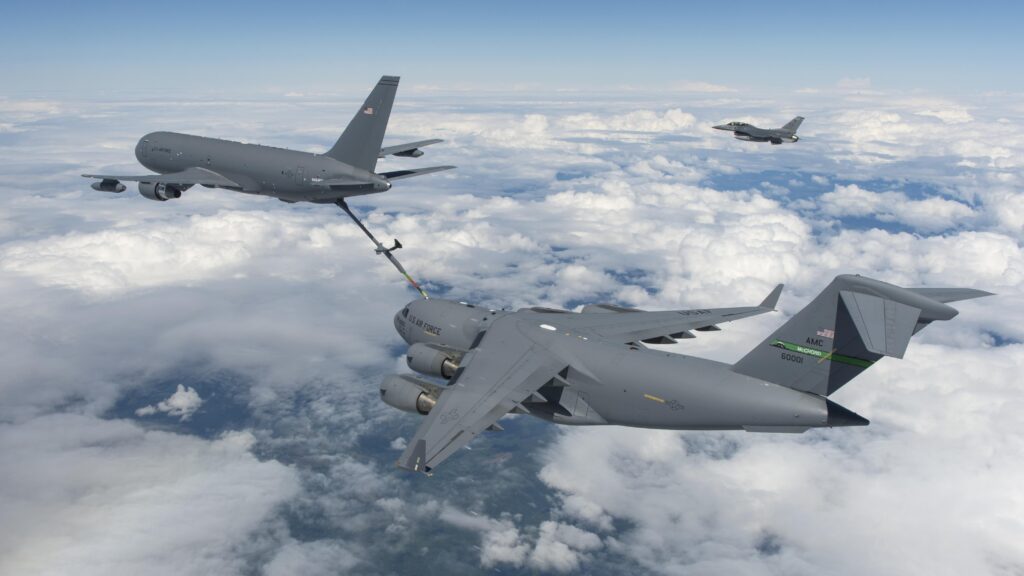
A KC-46 tanker refuels a C-17 transport in mid-air.
WASHINGTON: The head of the Air Force’s Rapid Capabilities Office (RCO), Randy Walden, said that of the 40-odd programs his team manages, right now they need the most help with the department’s flagship battle management, command and control effort.
“I’ll touch on one [program] that I think we need the most support on recently, and that’s the Advanced Battle Management System,” he told the National Security Space Association’s SpaceTime Zoom broadcast today, in answer to a question from moderator Mandy Vaughn, CEO of GXO, Inc., about how industry can assist RCO.
“In general terms, I’ll say many of the same priorities and gaps you find in the unclass world exist in this classified world,” he said. “But ABMS is a good example of trying to leverage commercial industry and what they’ve done with a more global Internet of systems.”
ABMS is the Air Force’s planned component of DoD’s wider Joint All Domain Command and Control (JADC2) concept. The program has hit some turbulence as new Air Force Secretary Frank Kendall refocuses it on providing near-term capabilities to operators, as opposed to prototyping and experimentation with cutting-edge tech.
Walden said the central goal of ABMS is to “compress the timeline” for command decisions to be made.
A critical issue in allowing that to happen, he explained, is getting service users to figure out what data they have, what data they need, and perhaps most importantly, how to share that data with each other via lightning fast artificial intelligence algorithms and machine-to-machine links, rather than “lethargic, human intensive” paper requests and orders.
“If you don’t know your data, it’s gonna be very hard to share, and it’s gonna be very hard to actually figure out what you want to do in the future. So, you do have to have some level of insight in the data you have,” he said. “Most of my job is asking others out there: ‘What data do you have and how would you like to share it from the battle management perspective?’ That requires those organizations and those individuals to think about what they want to do.”
Another central other issue for RCO, Walden said, is trying to “scale up” useful tech emanating from the scores of little contracts awarded for prototyping and demonstrations by the Chief Architect Preston Dunlap’s office prior to transition of ABMS to a program of record. RCO — which since its inception in 2017 has been focused on speeding new capabilities to warfighters under mostly highly classified programs, such as the B-21 bomber development — was tapped by as the acquisition authority for ABMS last November.
“A lot of the work we’ve been doing is trying to pick up where the where, originally, the chief architect left off, which was more of, essentially, their prototyping and demonstrations and On-Ramps. And so we took it from there — for which they had a lot of contracts — and the goal was to essentially start to extend and scale that up … in leveraging commercial industry’s 21st century technology,” he said.
For the moment, Walden said, RCO is concentrating on getting what is known as ABMS Capability Release 1 (CR-1) into the field. CR-1 is a set of software, applications and systems linked primarily to the fielding of new pods for the KC-46 tanker jets that allow them to serve as a kind of flying cell tower between the incompatible radio systems of F-22 and F-35 fighters.
The goal of CR-1, he explained, is to create “some sort of a gateway at the tactical edge, because the tanker is going to be there anyways. And so the goal would be to not only supply fuel for aircraft needing it at the time — whether you’re a tactical aircraft, a bomber, etc. — but at the same time be associated with sharing or refueling data.”
The communications gateway pod would allow tanker crews “to share the most recent information” about where they had been with pilots in other aircraft, he explained, but also on the ground in Air Operations Centers or Maritime Operations Centers, far-flung command headquarters, all the way up the chain through the Joint Chiefs of Staff to the president.
The difficulty, however, is figuring out how to allow platforms, weapons, and command systems, including those of the other services if they so wish, to automatically link to that gateway into a wider ABMS network, he noted.
“The challenge is taking the data that you want to share — you got to understand it, and how you want to share it — and then write the applications that give you that data quality at the highest level, and compress timelines for those decision makers,” Walden said.






















